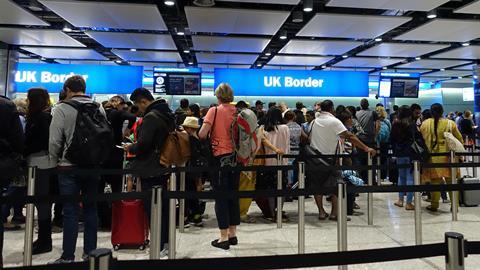In an in-depth report published by the Building the Future Think Tank this week, we look at how Brexit has changed the way we recruit foreign workers – and the implications of that decision. Read the first part of our analysis today

This week the Building the Future Think Tank is serialising its 15-page report looking in depth at the current immigration system and its impact on the construction industry. Over five days we will set out the case for reform, culminating in a set of recommendations.
Today’s article provides an introduction to all of the issues and sets out why our research has led us to believe that immigration reform is vital – but must reflect the political reality in this country.
Introduction
The end of freedom of movement with the EU and the setting up of the points-based immigration system has changed the basis on which the construction industry operates. The industry now struggles to bring in the skilled staff it needs from overseas and is totally unable to hire foreign-born, lower-skilled workers.

The risk of this approach to immigration, as outlined in a recent Financial Times column by academic and former Treasury economist Prof Jonathan Portes, is that the UK could get stuck in a low-growth “economic doom loop” if it does not change course.
The new Labour government now offers the construction industry an unprecedented opportunity to make the argument for an immigration policy that helps deliver sustained economic growth.
Labour has promised to make economic growth its defining central mission, with a promise of securing the highest sustained growth among the G7 nations. However, it has also pledged to reduce net immigration. Given net immigration has tripled since freedom of movement ended in 2020, reducing it is an understandable ambition on the part of the new government. But it is clear, not least from data published annually by the Office for Budget Responsibility (OBR), that migrants boost the economy overall. Indeed, the OBR states that a “low migration scenario” would push the UK’s budget deficit up by £13bn at the end of the next parliament.
The sector can now be a more forceful voice in making the case for migration as one vital part of a managed plan for delivering growth and prosperity that benefits everyone in the country
For construction, over the decade preceding Brexit the industry became accustomed to using overseas workers, particularly from the EU, to deliver major projects – with more than one in 10 workers being from abroad at the peak. The incoming government has made clear that in construction – and other industries – it does not see this kind of long-term reliance on overseas workers as sustainable. However, there is more widespread acceptance of the need to allow migration to tackle immediate skills shortages – and Labour has made clear that it will reform the current system with an eye to growth.
While the industry’s reliance on migrants may not have been a desirable situation in the long term, it is already becoming clear that the new points-based immigration system does not work for the sector at any level. Construction is facing a huge challenge in recruiting just the workers it needs to replace existing staff as they retire, let alone those who will be necessary if there is a major period of growth.
The sector can now be a more forceful voice in making the case for migration as one vital part of a managed plan for delivering growth and prosperity that benefits everyone in the country. The evidence is clear that migrants generate far greater economic benefits than costs, overall.
With a new government, the industry must grasp the opportunity to make the case for the changes it needs to help the UK deliver growth.
This Building the Future Think Tank report sets out ideas of how the current system might be reformed, within the bounds of political reality, to ensure a better system is created.
How we compiled our report

A survey on key topics was sent out to Building subscribers, which was completed by around 130 consultants, contractors and specialists – as well as others in academia, government and developers. This survey formed a key part of the evidence base for the views of the sector, alongside a desk review of literature on the subject.
In addition, a core group of advisers – the Building the Future Think Tank advisory panel – participated in two roundtable discussions to further develop the themes and ideas in this report.
The feedback from both forums, along with the literature review and the subscriber survey, contributed to the conclusions and recommendations ultimately arrived at. However, the views expressed in the report are those of the author and Building magazine alone, and participants cannot be assumed to have endorsed the final findings.
We are hugely appreciative of the input given by the Building the Future Think Tank advisory panel members. These were:
- David Barnes, head of policy and public affairs, Chartered Institute of Building
- David Bishop, project director, Build UK n James Butcher, director of strategy and operations, National Federation of Builders n Mark Farmer, chief executive, Cast, and government-appointed independent lead reviewer for the arm’s-length body review of industry training boards
- Iain Lindsay, head of talent, John Sisk & Son n Phoebe MacDonald, head of policy and public affairs, RIBA
- Laura Markus, policy and external affairs manager, Home Builders Federation
- Tom Mayhew, partner, Simons Muirhead Burton
- Marley Morris, associate director – migration, trade and communities, Institute for Public Policy Research
- Alasdair Reisner, chief executive, Civil Engineering Contractors Association
- Heather Rolfe, director of research and relationships, British Future
- Daliah Sklar, chief executive, founder and UK immigration expert solicitor solicitor, DRSI Borderless Jobs
- Gary Sullivan, chair, Wilson James
- Rico Wojtulewicz, head of policy and market insight, National Federation of Builders
Implications of Brexit
Prior to the vote to leave the EU in 2016, the construction industry had been heavily reliant on workers from the EU, largely from eastern Europe; this was particularly so in London and the South-east. The proportion of overseas-born construction workers peaked at over 12% nationally, but made up more than half of workers in the capital. EU workers were free to move to the UK without restriction. Since then, the UK has moved to a system of managed migration designed to prioritise workers with higher-level skills or training.
The points-based immigration system was finally introduced at the end of 2020, 11 months after the UK’s ultimate departure from the EU in January 2020. This system replaced freedom of movement, which had existed in the UK as a basic right allowing all EU citizens to live and work in any EU country (except for citizens from new member countries, where transition periods limited this right).
The new points-based system, which is based on the Australian model, allows workers to come to the UK under a skilled worker visa only if they work in a qualifying occupation, possess a minimum skill level, speak English to the required standard, are offered the necessary minimum salary (generally £38,000) and have a qualified sponsoring employer.
While the system is much more restrictive than freedom of movement was for EU workers, it is more generous than the previous system was for workers from elsewhere in the world. This fact, coupled with international crises in Ukraine, Afghanistan and Hong Kong, means levels of overall migration to the UK have been at or close to record levels since the introduction of the points-based system. A net 746,000 people moved to the UK in 2022. However, the vast majority of this increase in migration has been accounted for by students, people arriving under humanitarian visas, and those working in specific sectors such as health and social care.
The evidence suggests that for construction specifically, the system has so far failed to work. A Construction Industry Training Board (CITB) survey last year found just 7% of construction firms had signed up as sponsors, while the Civil Engineering Contractors Association (CECA) told us an even smaller proportion of its members – less than 5% – are signed up.
Migration policy should be driven by a sectoral industrial strategy that considers the overall skills needs of the industry, and what role migration will need to play in that
Government data shows that in the last two years fewer than 6,000 skilled worker visas have been issued in the construction sector – equivalent to less than 0.3% of its more than two million-strong workforce.
The industry finds the new system much more difficult in principle than freedom of movement. However, evidence also suggests there are specific hurdles around how it has been implemented, beyond the principle of the system. These include the way it fails to fit with the project-to-project nature of the industry, the bar on hiring those with lower skill levels, a lack of awareness of the system, and the English language requirements. The new Labour government has now made growth the central mission of its time in office, and with planning reform a major thrust of that, construction will have to be able to grow if the government is to deliver on its mission.

According to the CITB, the industry already needed to hire an extra 250,000 people in the next five years to meet the “modest” demand projected prior to Labour’s election. Delivering the necessary workforce and skills – and more on top if the new government’s growth mission is to be fulfilled – simply from a domestic talent pool is likely to be very difficult.
Given that situation, this report suggests reforms to the current system which might allow immigration to temporarily supplement the domestic workforce. However, it is not seen as politically feasible or realistic to recommend a return to freedom of movement – however desirable that may seem to many employers.
The reality is that the construction industry will continue to be under pressure to fill the bulk of its staffing needs from the domestic workforce
The reality is that the construction industry will continue to be under pressure to fill the bulk of its staffing needs from the domestic workforce, and any loosening of migration rules should not be seen as allowing a permanent reliance on overseas labour for core workforce requirements.
Our contention is that the existing system can be reformed in such a way that:
- Migration policy should be driven by (and flow from) a sectoral industrial strategy that considers the overall skills needs of the industry, and then what role migration will need to play in that.
- There is a new quid pro quo agreed, in which a looser points-based system benefiting the industry be allowed, on the basis that the sector fulfils government requests on training and skills.
- There is, further, exploration of a sectoral deal for construction (as for social care and seasonal agricultural work) that allows lower-skilled migrants to enter the UK, where evidenced. This should include exploration of a way for workers to no longer be tied simply to one employer, such as through a clearing-house system.
- The settlement for construction professionals is reviewed, particularly on minimum salaries for visas, including for younger professionals.
If all the above is done, then it is our belief that the new government should be able to harness the creativity and energy of the industry to drive economic growth, while sticking to the principles of the points-based system.
This could allow the government to deliver the growth it has promised, without sacrificing the pledges it has made to the electorate around immigration policy and on not reversing the Brexit settlement.
Read the rest of our report in further instalments
Today’s introduction is the first in a series of articles looking in depth at the current immigration system. Over the coming days we set out the case for reform:
- On Building tomorrow: Chapter 1: Staffing the industry prior to Brexit and Chapter 2: The new policy environment
- On Wednesday: Chapter 3: How the new settlement has bedded in
- On Thursday Chapter 4: Why the new system is not working
- On Friday: Chapter 5: How the new system can be reformed and recommendations for change
At our conference on 18th September we will release the full 15-page report, which will be available as a downloadable pdf.
The Building the Future Think Tank is our research hub producing indepth research on behalf of the industry. Last year we published three major reports into ways to shape a better built environment, more research will be published later this month.

Building the Future Conference is back … at Church House, London, 18 September

The Building the Future Conference is set to return to central London on 18 September, bringing together leading industry experts to unpack the biggest issues facing the built environment.
Keynote speakers include Mark Robinson, chief executive, Scape Group, and Eoghan O’Lionaird, chief executive, Wates.
Our panel sessions focus on net zero, building safety and driving productivity on construction projects. They will be fully interactive, allowing you the chance to have your say, and put your questions to any of our expert speakers.
For attendees we will be launching three more research reports linked to the themes of the conference.




























1 Readers' comment